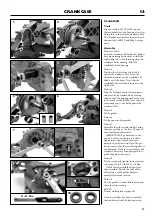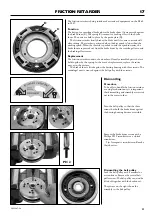
49
FRICTION RETARDER
17
PH 2
A
A
A
A
B
C
D
502 53 07-26
The friction retarder is being introduced as standard equipment on the K960
in 2007.
Function
The design is a centrifugal brake where the brake shoes (A) are pressed against
the brake drum (B). The spring (C) transmits a braking effect to the brake
shoes. The units are held in place by the guide plate (D).
The friction retarder slowly brakes the blade until it comes to a standstill
after cutting. The retarder is activated when the disc speed is lower than the
working speed. When the throttle is pushed in and the speed increases, the
brake shoes are pressed out from the brake drum by the centrifugal force, and
the braking effect ceases.
Replacement
The friction retarder consists of a number of loosely assembled parts that are
held together by the spring. In the event of replacement, replace the entire
unit, as in the picture.
The brake drum is fitted against the bearing housing with three screws. The
centrifugal unit is secured against the belt pulley with four screws.
Dismantling
Procedure
To be able to handle the friction retarder
as a single coherent unit, it is important
that dismantling and assembly are carried
out in the correct order.
Turn the belt pulley so that the three
screws that hold the brake drum against
the bearing housing become accessible.
Remove the brake drum screws with a
Phillips PH 2 screwdriver or a slotted
screwdriver.
Tip: A magnetic screwdriver will make
the job easier.
Dismantling the belt pulley
Lock the belt pulley with a mandrel or
a screwdriver. Remove the central belt
pulley screw. The belt pulley can now be
lifted off together with the brake unit.
The picture on the right shows the
assembly in the belt pulley.






































